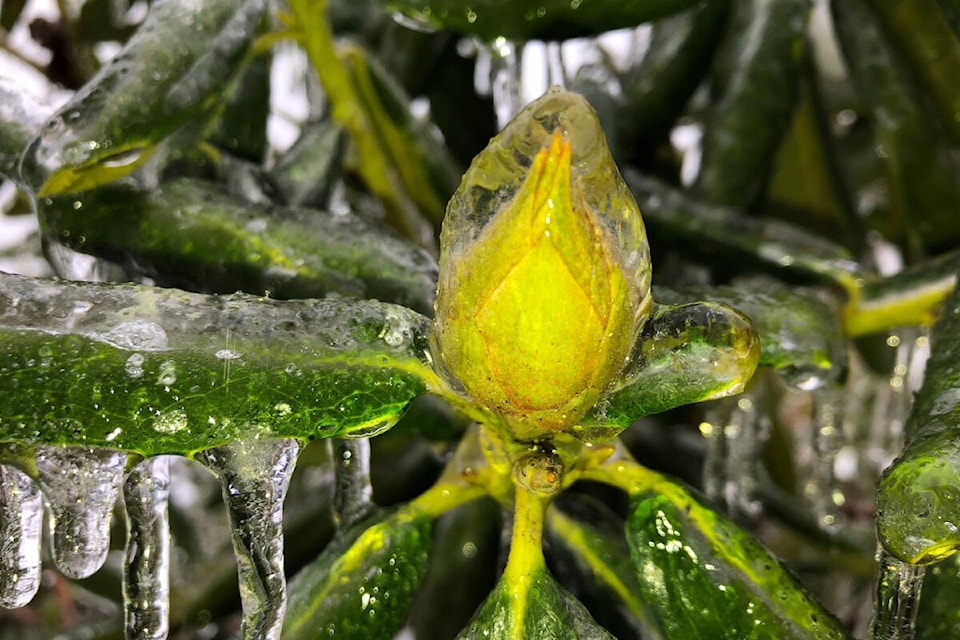By Pam Erikson/Special to Langley Advance Times
We have spoken a lot these past two years about all the adverse weather conditions that have affected our gardens – from heat domes to droughts to floods.
We continue to get a lot of questions from gardeners with respect to what to do, what to grow, and how best to deal with these ongoing challenges.
Many situations that have occurred have been anomalies – weather patterns that we have not encountered before, which makes it very difficult to predict what will come.
But, we can work in a way to have a better chance of plant survival.
Let’s start with lawns.
For many years, we have maintained that grass goes dormant when stressed with heat, with new growth returning in the fall with the rains. While this is still the norm for most lawns, we have seen some lawns (mainly those in full sun with zero irrigation all summer) that have suffered badly from heat stress due to prolonged drought.
RELATED LANGLEY GREEN THUMB: Stressful season for gardens
Those lawns will require good power raking and aeration in the early spring. These treatments will remove the dead thatch and allow air to the roots.
Top dressing of a fine layer of topsoil followed by a good spring fertilizer will help rejuvenate the stressed grass and overseeding in the more damaged areas will help fill in the lawn.
We have seen in our own gardens that lawns that have a few trees planted around have survived much better with that little bit of shade protection.
Since water conservation is a huge issue for those of us who live on an aquifer, we do not water our lawns at all. But, due to the scattering of trees around the lawns, ours are coming back this fall – happy to see some green!
Trees were a huge issue this year.
As I drive around, I see so many cedars, mainly the Smaragd variety, that have completely died this past summer.
Keep in mind that when you plant a new hedge, it must be kept well watered for the first six months until well established. If you plant a hedge in the spring, a good soaker hose is an excellent investment and will help the hedge get through the summer until the fall rains start.
Well established hedges fared much better, although we have seen a few trees within a hedge that started to turn colour in the summer – so keep an eye on any tree that starts to look different than the rest and ensure it gets some water.
Hedges are generally a big investment, so a little time and effort put into keeping them healthy is essential.
Annual plants – like the impatiens, marigolds etc – that everyone likes to add for colour, are usually available in the garden centers by March.
However, keep in mind, as was the case this past spring – that if the weather is cold and wet, the annuals do not do well.
The rule of thumb in our garden is not to plant any annuals until the May long weekend.
I talked to so many people last year who purchased too early and ended up ripping them out and purchasing again. If you have a greenhouse to put them in, that’s fine – just keep in mind that they thrive better when it’s warmer.
Perennials are still the mainstay and backbone of any garden.
While some have not been happy during all the bizarre weather, they are the toughest plants in the garden and for the most part will be fine.
Most perennials have a built-in defence system – if we are in the middle of a drought, they will go dormant and live on the moisture stored in their roots, with new growth coming when they see rain or irrigation again.
Hostas were a wonderful example of that this past summer. While they are reputed to be shade loving, moisture loving plants, our hostas performed amazingly after three months of drought. Their herbaceous root systems are so thick and full of moisture that they kept on going no matter what.
PAST LANGLEY GREEN THUMB: Gardener’s in hosta heaven
As gardeners, we all like to see our plants succeed.
We just need to keep more things in mind when planting now.
Make sure if you are planting in a wet area that there is good drainage – and don’t plant things that don’t like to sit with wet feet.
If you are planting in an area that is full sun, do your research and make sure you plant things that will be happy there during the heat of the summer. During the heat dome two years ago, I moved a table and umbrella to one area of the garden where the plants were not happy due to the intense heat – this definitely helped and they came through just fine.
Spring is just around the corner now – time to start those plans.
– Pam Erikson is owner of Erikson’s Daylily Gardens and Perennials and president of the Langley Garden Club.
.
story tags
